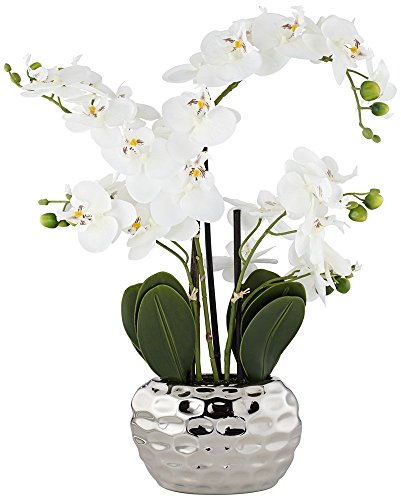Thanks everyone for your points of view. I think this is turning out to be an interesting discussion. Leo, I can understand your points of view, and I have to agree with some of them. Also PaphMadMan makes some interesting points which I have to agree with.
A few things I have to add, even if you keep the species or the varieties "pure" over time they will look nothing like the original wild type, so intentially or unintentially we are creating "man-made" species. Think of the wild type Paph. bellatulum or Paph rothschildianum versus some of the most recent awarded plants. We select for larger, flatter, darker flowers. We select for the strongest growing plants that do well as a seedling in a "lab situation" (I do that myself I always replate the strongest and largest plants and throw away the weakest plants). I have noticed if we deal with a new species say besseae or kovachii, that the first generation seedlings have a much harder time growing in the lab than the say the third or fourth generation. By that time they grow like weeds, because they are adapted to the growing conditions in the lab. And then when they are growing in the greenhouse again we select for plants that do well in an artifical growing environment. Unintentially we keep throwing out the "wild type" plants, so say after 5 to 10 generations we may have selected plants that cannot even grow in the wild anymore.
Another point that I wanted to make is something I learned in my Plant Breeding Classes. And that is "Hybrid Vigor" or also known as "Heterosis". The following picture of corn shows what I am talking about:
http://images.google.com/imgres?img...-a&rls=org.mozilla:en-US:official&hs=Y7p&sa=N
Here is an easier explanation of Heterosis:
http://en.wikipedia.org/wiki/Heterosis
Basically if you cross 2 populations or lines that have been inbred, the resulting hybrid has hybrid vigor, and the plants, flowers, fruit etc will be much larger than either parent. Hybrid vigor does not necessarily have to be between 2 different species, it also occurs within a species. But it does explain why usually the hybrid of 2 species say if you cross Phrag. fischeri onto Phrag. schlimii to make Phrag. Pink Panther, is much stronger and the flowers are bigger than either parent.
Someone brought up the species Laelia purpurata, It is true there are a lot of different strains or varieties like var carnea, var schusteriana, var russeliana, var ardosa etc. I agree I think it is good to keep crossing plants within the same variety to keep them pure. But I also think it is a good thing to cross the different types together. These plants have been selfed and sibbed for many generations, so you have some unintentional "inbred" lines, which have made these plants weaker, with smaller flowers, and probably less disease resistance. I have crossed some of these types together, and voila I got Hybrid Vigor. The plants are growing very strong (more so than the parents), and the flowers are larger than either parent. Also I get more Variation, and different flower colors pop up, which makes it more interesting for me as a breeder. Now I agree I can't call them var carnea or var shusteriana anymore, but they still will be Laelia purpurata's.
Now Leo brought up a point, and if someone else buys say one of these Laelia purpurata's and changes the tag by giving it a wrong variety name, because it looks like var. russeliana, but it has much larger flowers. That is their conscience and not mine. I have labeled mine correctly by saying it is Laelia purpurata (var russeliana x var. shusteriana).
Lastly I want to bring up one other reason for making crosses of similar species, is "curiosity", or as a geneticist I want to know the genetics of a plant. For instance Leo said he would never cross a Phrag. wallisii with a Phrag. caudatum. Well I have crossed Phrag. wallisii with Phrag. lindenii. I think both of them are very closely related, and I wanted to know how the characteristic of "Pouchlessness" gets inherited. Also I believe that lindenii, is just the "pouchless form" of wallisii, so my hypotheses is, if I cross the 2, that they will look identical to wallisii. Next I want to sib some of them to see if some will revert back to the lindenii type. I don't see anything wrong with that as a scientist, as long as I label them correctly, now if someone else takes one of these "hybrids" to a show and labels them incorrectly again that is their fault and not mine. If I show that the hybrid looks identical to Phrag. wallisii, maybe we will have to rethink the "species" concept, and call them the same species. In this case you don't have to worry about "labels" as the hybrid between the 2 will be the same species again. In many cases like this where it is hard to distinguish a hybrid between one of the parents (goes for dalesandroi/besseae/Jersey as well) I would consider myself a Lumper, and just call them all the same species, this will avoid any "labeling" issues as well, and this goes back to my first point that I made in my first post, is that "labeling" a plant is a man-made and artificial concept. Plants in nature are much more fluid than that.
Robert









































